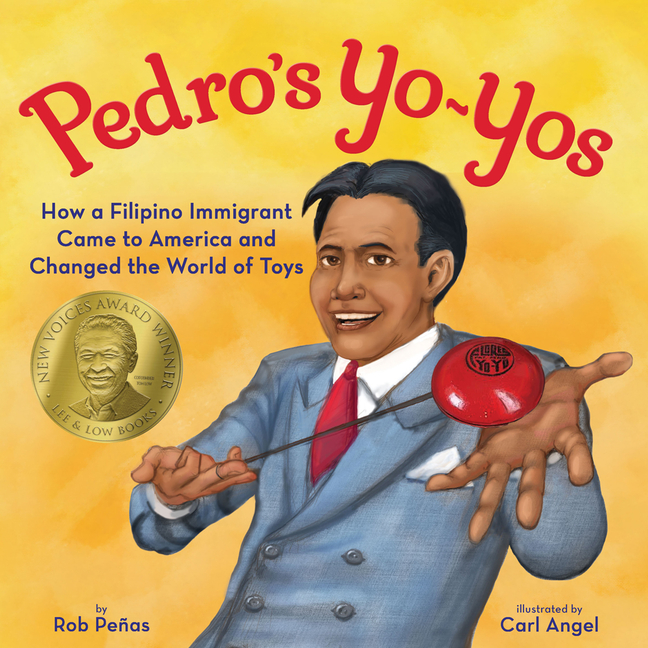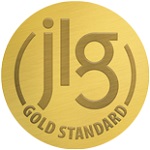
Book Resume
for Pedro's Yo-Yos: How a Filipino Immigrant Came to America and Changed the World of Toys by Rob Peñas and Carl Angel
Professional book information and credentials for Pedro's Yo-Yos.
5 Professional Reviews (1 Starred)
2 Book Awards
Selected for 1 State/Province List
See full Book Resume
on TeachingBooks
- School Library Journal:
- Grades 1 - 4
- Publisher's Weekly:
- Ages 4 - 7
- Booklist:
- Grades 1 - 3
- TeachingBooks:*
- Grades PK-4
- Cultural Experience:
- Asian American
- Immigrant / Refugee
- Year Published:
- 2024
4 Subject Headings
The following 4 subject headings were determined by the U.S. Library of Congress and the Book Industry Study Group (BISAC) to reveal themes from the content of this book (Pedro's Yo-Yos).
5 Full Professional Reviews (1 Starred)
The following unabridged reviews are made available under license from their respective rights holders and publishers. Reviews may be used for educational purposes consistent with the fair use doctrine in your jurisdiction, and may not be reproduced or repurposed without permission from the rights holders.
Note: This section may include reviews for related titles (e.g., same author, series, or related edition).
From School Library Journal
September 20, 2024
Gr 1-4-Pedro Flores was born in the Philippines in 1896, when the country was under the rule of Spain and Filipinos were treated as second-class citizens. Flores spent his little free time with friends playing with a toy they called yo-yo, which means "come back." When Spain sold the Philippines to the United States, it was an opportunity for teenage Flores to come to this country. While in America, he taught the family he lived with one of his favorite pastimes, playing with his handmade yo-yo and showcasing various tricks. Soon they were all hooked, sharing yo-yos with family and friends. Eventually, the demand became so large, Flores was sharing it with the world. Though he didn't invent it, Flores made the yo-yo what it is today, taking a simple toy and making it a part of our collective childhoods. Illustrations beautifully depict the key moments of Flores's life and enhance the text. Back matter includes a more detailed history of the Philippines, the yo-yo, and Flores. VERDICT A well-researched and readable biography that would be a great addition to all libraries, or used in units about immigrants, inventions, and their potent overlap.-Kristyn Dorfman
Copyright 2024 School Library Journal, LLC Used with permission.
From Horn Book
May 1, 2024
Born in 1896 under Spanish colonial rule in the Philippines, Pedro Flores immigrated to the United States as a teenager. It wasn't until years later -- after he had worked in Hawaiian pineapple fields, on steamships in the Pacific, and at a hotel in California -- that he produced the first Flores yo-yo. Though Flores did not invent the toy (Penas traces its origins back thousands of years to China), his ingenious reengineering of it led to its rise in popularity (the word yo-yo means "come back" in Tagalog). Penas's straightforward text is well supported by deeply saturated images that illustrate Flores's experience as an immigrant: long hours of physically demanding labor and the dogged pursuit of education. It was with the help of a neighbor that Flores was able to start his business, and he committed to bringing his fellow kabayan into his success, as employees. Readers will delight in learning (or remembering) how to "Rock the Baby," "Loop the Loop," and "Walk the Dog." An author's note provides history about the Philippines, the yo-yo, and Flores's life. Gabi Kim Huesca
(Copyright 2024 by The Horn Book, Incorporated, Boston. All rights reserved.)
From Publisher's Weekly
April 15, 2024
This contextualizing origin story of one of the most successful toys of all time doubles as the biography of Filipino entrepreneur Pedro Flores (1896â€"1964). Born during Spain's rule of the Philippines, Flores immigrated to the United States at 15 after the country was sold to the U.S. Arriving in Honolulu, he labored in pineapple fields, then took work on steamships, before heading to high school years later. Working as a bellhop in Santa Barbara, he "felt no better off than when he left the Philippines," Peñas writes. To entertain the child of a family he stayed with, he carved a wooden yo-yo, a version of a childhood toy he'd played with back home, and taught the boy tricks. Word spread, and Flores soon opened one factory, then more, to manufacture yo-yos. Angel's uneven digital illustrations capture experiences of colonialism and labor alongside the joy of a new toy in this well-researched picture book affirming ingenuity and perseverance. An author's note and more concludes. Ages 4â€"7.
From Kirkus
Starred review from February 1, 2024
How the toy that taught millions to "walk the dog" and "rock the baby" came to America. In the wake of the American occupation of the Philippines following the Spanish-American War, Pedro Flores (1896-1963) emigrated at 15 to work as a bellhop. He invented a refined version of what was known in his childhood as a yo-yo--a term that means "come back" in Tagalog--and ended up having to open multiple factories to keep pace with the demand. When he later sold the business to Chicago entrepreneur Donald Duncan, he stayed on for years and oversaw promotional demonstrations and competitions that sent the popular toy all over the world and even into space. Though, as the author explains in an afterword, the yo-yo (first called a "bandalore" and originally from China) was known in other countries, it was not all that popular until Flores redesigned it with a slip-string to make it more versatile; he also came up with some of the most spectacular yo-yo tricks himself. One illustration of him dramatically showing them off before an astounded crowd may inspire young yo-yo enthusiasts to make use of the helpful leads to print handbooks and websites found at the tail end. Bright smiles on the faces in Angel's illustrations add even more warmth to Pe�as' insightful and stirring account. A glowing addition to the stories of immigrants who have made good in this, their new country. (Picture-book biography. 7-9)
COPYRIGHT(2024) Kirkus Reviews, ALL RIGHTS RESERVED.
From Booklist
February 1, 2024
Grades 1-3 Pedro Flores was a Filipino immigrant who brought the yo-yo to America and made it a worldwide phenomenon. In Pe�as' informative picture book, he describes how Flores overcame the challenges of living under colonial rule, migrating to a new country in 1915, and starting his own business from scratch. Opportunity knocked on his door when an American family took interest in a yo-yo he made for their son. Soon, everyone's interest was piqued, and Flores spent his time carving yo-yos at night and demonstrating tricks with them during the day. The yo-yo became a sensation, and he expanded his homemade business to several factories. Flores' determination and entrepreneurial spirit ensured that the yo-yo would capture the imagination of children and adults worldwide. The concise text, which nicely encapsulates key moments from Flores' life, is beautifully accompanied by Angel's naturalistic and expressive digital paintings, especially when depicting Flores' impressive yo-yo tricks. Robust back matter elaborates on Flores' life, the colonization of the Philippines, and the further history of the yo-yo.
COPYRIGHT(2024) Booklist, ALL RIGHTS RESERVED.
2 Book Awards & Distinctions
Pedro's Yo-Yos was recognized by committees of professional librarians and educators for the following book awards and distinctions.
1 Selection for State & Provincial Recommended Reading Lists
Pedro's Yo-Yos was selected by educational and library professionals to be included on the following state/provincial reading lists.
United States Lists (1)
Primary Source Statement on Creating Pedro's Yo-Yos
Rob Peñas on creating Pedro's Yo-Yos:
This primary source recording with Rob Peñas was created to provide readers insights directly from the book's creator into the backstory and making of this book.
Listen to this recording on TeachingBooks
Citation: Peñas, Rob. "Meet-the-Author Recording | Pedro's Yo-Yos." TeachingBooks, https://www.teachingbooks.net/bookResume/t/97195. Accessed 19 January, 2025.
Preview Digital Book
Explore Pedro's Yo-Yos on Marketplace. Access requires OverDrive Marketplace login.
This Book Resume for Pedro's Yo-Yos is compiled from TeachingBooks, a library of professional resources about children's and young adult books. This page may be shared for educational purposes and must include copyright information. Reviews are made available under license from their respective rights holders and publishers.
*Grade levels are determined by certified librarians utilizing editorial reviews and additional materials. Relevant age ranges vary depending on the learner, the setting, and the intended purpose of a book.
Retrieved from TeachingBooks on January 19, 2025. © 2001-2025 TeachingBooks.net, LLC. All rights reserved by rights holders.


 Junior Library Guild Selections, 2012-2024, Biography Selection, 2024
Junior Library Guild Selections, 2012-2024, Biography Selection, 2024
